Procyon, Alpha Canis Minoris (α CMi), is the primary component in a binary star system located only 11.46 light-years from Earth in the constellation Canis Minor. With an apparent magnitude of 0.34, it is the brightest star in Canis Minor and the eighth brightest star in the sky. Like its brighter neighbour Sirius (the Dog Star) in Canis Major, Procyon is one of the nearest stars to the Sun.
The Little Dog Star appears so bright to us mainly because of its proximity and not its intrinsic brightness. It is slightly fainter than Rigel in Orion and a little brighter than Achernar in Eridanus. It is only rarely outshone by the variable supergiant Betelgeuse, which lies in the same area of the sky, but much further away from us than Procyon.
Star system
The Procyon system is composed of Procyon A, a white main sequence star of the spectral type F5 IV-V, and Procyon B, a much fainter white dwarf companion with the stellar classification DQZ. The primary component is coming to the end of its main sequence lifetime and will soon stop fusing hydrogen into helium in its core.
The companion star is a white dwarf, a stellar remnant that will gradually cool and fade over time. The white dwarf was once a star that expelled its outer layers into space, leaving behind an exposed hot remnant core. White dwarfs are the end products of moderate-mass stars that have reached the end of their life cycles.
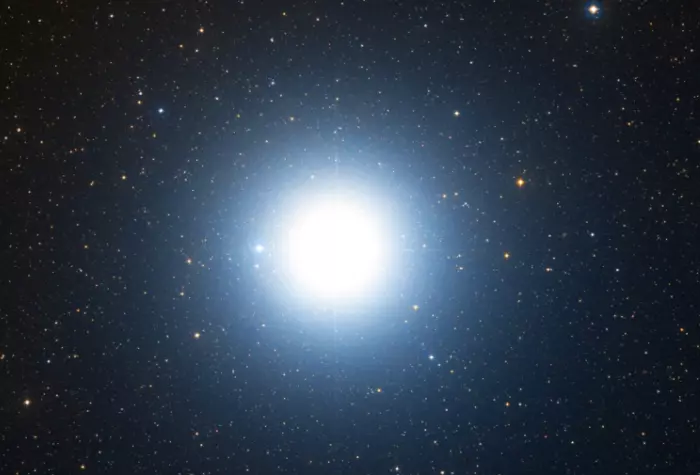
Procyon in Canis Minor. Image created using the Aladin Sky Atlas software from the Strasbourg Astronomical Data Center and DSS (Digitized Sky Survey) data. DSS is one of the programs of STScI (Space Telescope Science Institute). Credit: Roberto Mura (CC BY-SA 4.0)
The two components of the Alpha Canis Minoris system have an orbital period of 40.840 ± 0.022 years. They have an elliptical orbit with an eccentricity of 0.39785. Their orbit is inclined at 31.408° to our line of sight. The orbit takes the two stars within 8.9 astronomical units of each other and as far apart as 21 astronomical units. The average distance between them is 15 AU, almost equal to the distance from the Sun to Uranus.
Distance
Procyon lies 11.46 light-years from the solar system. It is the 14th nearest star system to the Sun. The primary component in the Procyon system is the 18th nearest individual star to Earth, as well as the nearest F-type star.
Most nearby stars are red dwarfs, too faint to be visible to the unaided eye. Procyon is the fourth nearest visible star to the Sun, after Alpha Centauri AB in the constellation Centaurus, Sirius in Canis Major, and Ran (Epsilon Eridani) in Eridanus.
Procyon A
Procyon A has the stellar classification F5 IV-V, indicating an evolved star still on the main sequence, appearing white in colour. The star’s brightness, which is high for its class, indicates that Procyon has almost run out of its core hydrogen and begun to expand as it continues to evolve into a subgiant star.
Procyon A has a mass of 1.499 solar masses and a radius twice that of the Sun. With an effective temperature of 6,530 K, it shines with 6.93 solar luminosities. The star’s estimated age is 1.87 billion years.
Procyon will continue to expand until it is 80 to 150 times its current size and turn orange or red within the next 10 to 100 million years as it becomes a red giant. It will ultimately end its life as a white dwarf, much like its fainter companion.
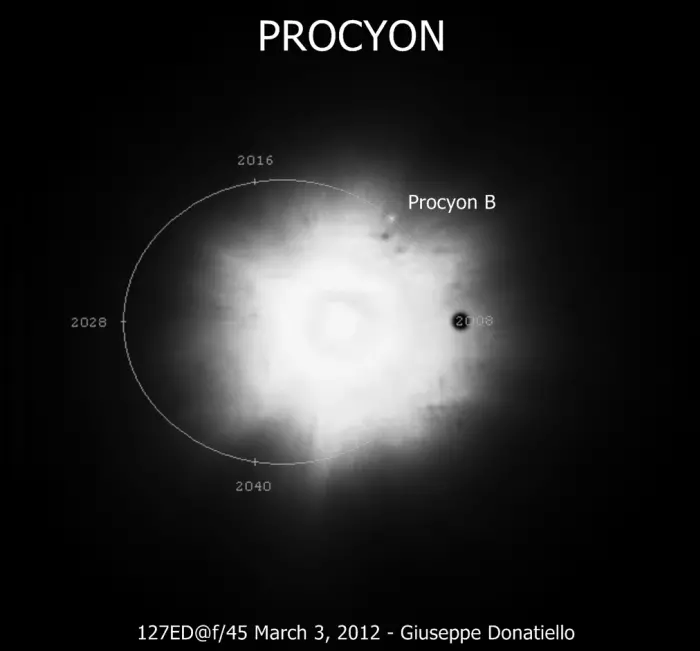
Procyon A and Procyon B, image credit: Giuseppe Donatiello (CC0 1.0)
Procyon B
Procyon B is much smaller than the primary star, with only 0.6 solar masses and a size of only 0.012 solar radii. It has an apparent magnitude of 10.7. The star’s existence was inferred from astrometric observations before it was confirmed visually.
White dwarfs are dense objects, packing a mass comparable to that of Sol into a radius similar to the Earth’s. The mass of Procyon B is unusually low for this type of star and the reason for this is uncertain.
Procyon B is harder to observe than Sirius B because the angular separation between the two components in the Alpha CMi system is smaller, only 5 arcseconds at the most. Procyon B is also fainter and significantly less massive than Sirius B, even though it has a larger estimated radius (8,600 km) than its neighbour (5,800 km). The remnant has a surface temperature of 7,740 kelvin.
Procyon B has the stellar classification DQZ, indicating a white dwarf star (D) with an atmosphere rich in carbon (Q) and heavy elements (Z).
Procyon B is hotter than Procyon A, with an estimated temperature of 7,740 K, but shines with only 0.00049 solar luminosities. It is also a little younger than its neighbour, with an estimated age of 1.37 billion years.
The estimated mass of the progenitor star was about 2.59 solar masses. The star is believed to have spent about 680 million years on the main sequence, fusing hydrogen in its core, before evolving into a giant, losing most of its mass through stellar winds, and ending its life about 1.19 billion years ago, when it became a white dwarf.
Facts
Procyon is part of three exceptionally bright and large asterisms that dominate the evening sky during the northern hemisphere winter: the Winter Triangle (the Great Southern Triangle), the Winter Circle (the Winter Hexagon), and the Egyptian X.
The Winter Triangle is formed by Procyon with its bright neighbours Sirius in the constellation Canis Major and Betelgeuse at the shoulder of Orion. The asterism contains most of the faint constellation Monoceros (the Unicorn) and can be used to find several famous nebulae and clusters that appear within its borders. These include the Rosette Nebula (Sh2-275) with the Satellite Cluster (NGC 2244), the Cone Nebula with the Christmas Tree Cluster (NGC 2264), and Hubble’s Variable Nebula (NGC 2261).
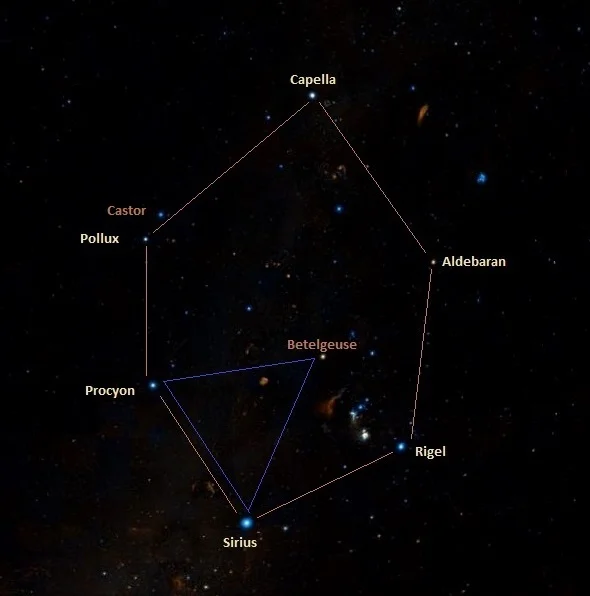
The Winter Triangle and the Winter Hexagon, image: Wikisky
The Winter Triangle extends into the Egyptian X, a larger asterism formed by two triangles: the Winter Triangle and the triangle formed by Sirius with Naos and Phact. Naos is the brightest star in the southern constellation Puppis (the Stern of Argo Navis) and Phact is the luminary of Columba (the Dove). The two triangles meet at Sirius. The fainter Naos and Phact can be found by extending lines from Betelgeuse through Sirius and from Procyon through Sirius.
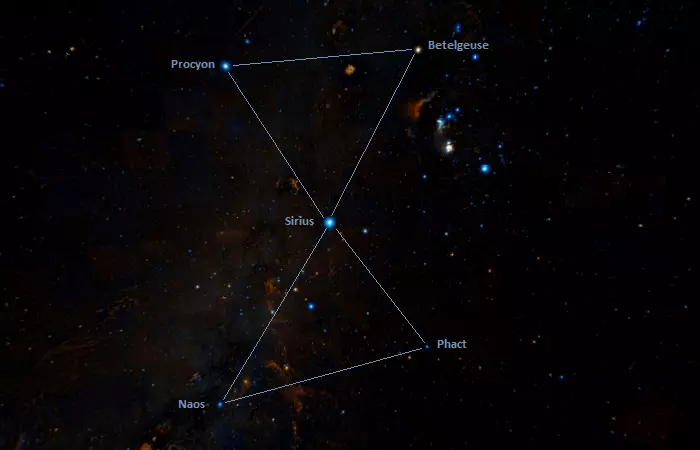
The Winter Triangle and the Egyptian X, image: Wikisky
The Winter Circle is formed by Procyon and Sirius with the bright Pollux in Gemini, Capella in Auriga, Aldebaran in Taurus, and Rigel in Orion. It is one of the brightest and largest asterisms in the night sky, with six first-magnitude stars marking its vertices, including Sirius, the brightest star in the sky.
As the names of these asterisms suggest, the best time of the year to observe them is during the northern hemisphere winter, when they are high above the horizon in the evening sky. Procyon reaches the highest point in the sky in late winter.
Procyon is one of the 58 bright stars that have been given special status in the field of celestial navigation. Navigational stars are some of the brightest and most recognizable stars in the sky. They include many of Procyon’s bright neighbours: Sirius, Adhara, Betelgeuse, Rigel, Bellatrix, Alnilam, and Pollux. Procyon is the only navigational star in Canis Minor.
The existence of Procyon B was first inferred in the 19th century. The German astronomer and physicist Friedrich Bessel was the first to propose that Procyon had an unseen companion in 1844. Bessel noticed irregularities in the motions of both Procyon and Sirius and attributed them to gravitational attraction of “dark” companions. His claim led to the discovery of both Procyon B and Sirius B.
In 1862, German astronomer Arthur Auwers calculated the orbital elements of Procyon B from its effects on the primary star. He detected Sirius B using the same method. At the time, telescopes powerful enough to observe the companion stars did not exist.
The existence of Procyon B was visually confirmed in 1896 by the German-American astronomer John Martin Schaeberle, who used the 36-inch refractor at Lick Observatory on Mount Hamilton in California. It was the largest refractor in the world between 1888 and 1897.
The proper motion of Procyon played a significant role in our understanding of the universe. Procyon, Sirius and Arcturus shifting enough across the sky since ancient times was what led to the discovery of proper motion in 1718. English astronomer and mathematician Edmond Halley is credited for the discovery. Halley compared his astrometric measurements to those provided by Ptolemy in his Almagest (2nd century CE) and found that the “fixed” stars were not in fact fixed.
The nearest star to Procyon is Luyten’s Star, a red dwarf located 1.12 light-years (0.34 parsecs) from Procyon and 12.348 light-years (3.7861 parsecs) from the Sun. With an apparent visual magnitude of 9.872, Luyten’s Star is invisible to the unaided eye. The red dwarf hosts two confirmed planets, one of which orbits in the star’s habitable zone. Seen from one of these planets, Procyon would be the brightest star in the sky, shining at magnitude -4.68.
Like many other bright and nearby stars, Procyon is often used in works of fiction (literature, films, television and video games). The best-known uses include M. A. R. Barker’s Tékumel (1940-) novels and games, L. Sprague de Camp’s Viagens Interplanetarias (1949–1958; 1977–1992) novels and short stories, Brian Aldiss’ novel Non-Stop (1958), Edmund Cooper’s Seed of Light (1959), Larry Niven’s A Gift from Earth (1968), and Stanislaw Lem’s His Master’s Voice (1968).
In medieval astrology, Procyon was one of the 15 Behenian fixed stars, to which astrologers attributed special powers. Procyon was considered a very fortunate star, portending fame and wealth. It was linked with the planets Mercury and Mars.
Name
The name Procyon (pronunciation: /ˈproʊsiɒn/) is derived from the Greek Προκύων (Prokyon), meaning “before the dog.” The name is a reference to the fact that Procyon rises before Sirius, the Dog Star, when seen from most locations north of the equator.
The International Astronomical Union’s (IAU) Working Group on Star Names (WGSN) officially approved the name for Alpha Canis Minoris A on June 30, 2016. Even though it formally applies only to the primary component, it is also commonly used for the entire system and for its fainter component (Procyon B).
The Chinese knew Procyon as the Third Star of South River (南河三). The South River was an asterism formed by Procyon with Gomeisa (Beta Canis Minoris) and Epsilon Canis Minoris. The asterism was part of the Well mansion, one of the southern mansions of the Vermilion Bird.
Procyon has been known by many other names throughout history. These include Antecanis (“before the dog”), the Latin translation of the name, and the Arabic names Al Shira, from aš-ši‘ra aš-šamiyah, meaning “the Syrian sign,” and Elgomaisa, from al-ghumaisa’, meaning “the bleary-eyed (woman).”
In an older Arabic tradition, Procyon was associated with the “bleary-eyed woman” and Sirius with “the teary-eyed woman.” Variants of Elgomaisa (Algomeiza, Algomeyza) were used on medieval astrolabes in Europe. Today, the star Beta Canis Minoris is formally known as Gomeisa.
Culture and mythology
Procyon is one of the 27 stars featured on the flag of Brazil. Each star symbolizes a Brazilian Federative Unit and Procyon represents the state of Amazonas.
The Kalapalo people in the Brazilian state of Mato Grosso saw Procyon and Canopus as part of an asterism called Kofongo, or Duck. The asterism signalled the beginning of the rainy season and the increase in manioc. The stars Castor and Pollux in Gemini represented the Duck’s hands.
Procyon and Sirius were mentioned in numerous ancient texts and played a prominent role in many ancient cultures, including Babylon and Egypt. To Babylonians, Procyon represented Nangar, an aspect of the god Marduk known as the Carpenter. In Babylonian lore, the Carpenter rebuilt the heavens and organised the sky, constructing stations for the gods, fixing their celestial likeness as constellations and defining the days of the year.
In Mesopotamia, Procyon was known as the Star of the Crossing Water Dog due to its location near the River of Heaven (the Milky Way).
The Greeks associated Procyon with Maera, a hound that belonged to Erigone, the daughter of Icarius of Athens. In Greek lore, Icarius was a follower of the god Dionysus, who taught him to make wine. When Icarius gave wine to some shepherds, they became intoxicated and, thinking they had been poisoned, they killed Icarius. Icarius’ body was found by his daughter and her dog. Erigone was so overwhelmed with grief that she hanged herself, while Maera jumped off a cliff. This made Dionysus so angry that he unleashed a plague on Athens and inflicted insanity on all unmarried women in the city, who all hanged themselves, just like Erigone. The plague only ceased after Athenians introduced rites to honour Icarius and Erigone. Dionysus placed the father, the daughter and the dog in the sky as the constellations Boötes (Icarius), Virgo (Erigone) and the star Procyon (Maera).
In Macedonian folklore, Sirius and Procyon were known as “the wolves” (Volci) circling around a plough with oxen, represented by the constellation Orion.
In Hawaii, Procyon was known as Puana, meaning “blossom.” It was part of an asterism called Ke ka o Makali’I, or “the canoe bailer of Makali’I.” It formed the asterism with Sirius, Capella, Castor and Pollux.
The Maori called Procyon Puangahori and Tahitians knew it as Anâ-tahu’a-vahine-o-toa-te-manava, or “star-the-priestess-of-brave-heart,” and considered it one of the pillars holding the sky.
The Inuit knew the star as Sikuliarsiujuittuq, which means “the one who never goes onto the newly formed sea-ice.” The name refers to a man who was too obese to go on the ice to hunt and instead stole food from other hunters in his village. The other hunters did away with him after persuading him to go on the sea ice. Procyon appears red during Arctic winter and the red colour symbolized the man’s bloody end.
Location
Procyon is very easy to find because it is a first-magnitude star and it lies near Orion, one of the most recognizable constellations in the sky, and Sirius, the brightest star in the sky. From mid-northern latitudes, Procyon appears just to the left of Orion’s hourglass asterism and above Sirius.
Even though there aren’t any bright deep sky objects in the immediate vicinity of Procyon, the star can be used to find several bright, large nebulae and star clusters in the constellations Monoceros and Canis Major.
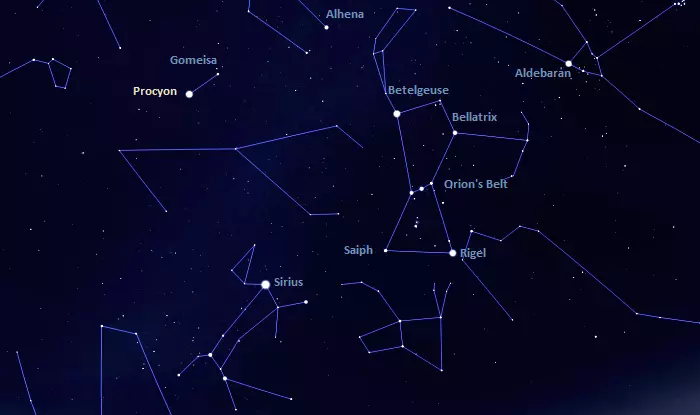
The location of Procyon, image: Stellarium
The Rosette Nebula, a vast H II region in the constellation Monoceros, lies in the region between Procyon and Betelgeuse. The nebula is associated with the Satellite Cluster (NGC 2244), a young open cluster easily visible in binoculars and small telescopes. Both the nebula and the cluster are catalogued in the Caldwell catalogue of deep-sky objects visible in amateur telescopes.
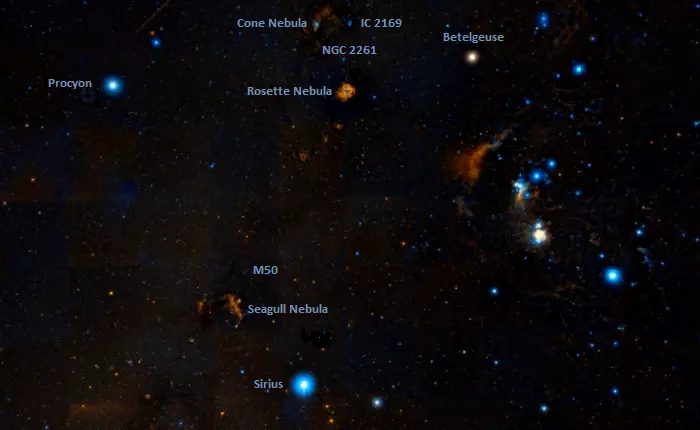
Procyon, Betelgeuse, Sirius, the Rosette Nebula, the Cone Nebula, the Seagull Nebula, and Messier 50, image: Wikisky
The famous Cone Nebula, a large H II region in Monoceros, appears just north of the line connecting Procyon and Betelgeuse. The stellar nursery appears next to the Christmas Tree Cluster (NGC 2264), a young open cluster approximately 2,350 light-years away. The nebula and the cluster occupy an area of 20 arcminutes. The cluster shines at magnitude 3.9 and can be spotted in binoculars, while the nebula is best seen photographically.
Dreyer’s Nebula (IC 2169) lies just west of the Cone Nebula. It is a reflection nebula about 25 arcminutes across.
Hubble’s Variable Nebula (NGC 2261) is a nebula illuminated by the young variable star R Monocerotis. It has an apparent magnitude of 9.0 but its brightness and shape vary over weeks and months. The nebula appears in the area of the sky between the Rosette and Cone nebulae.
Constellation
Procyon is located in the northern constellation Canis Minor, the Smaller Dog. Canis Minor is one of the Greek constellations, catalogued by the Greco-Roman astronomer Ptolemy in his Almagest in the 2nd century CE. In Greek mythology, it represents the smaller of the two hunting dogs following Orion, the Hunter. The larger dog is represented by the constellation Canis Major.
Canis Minor is one of the smaller constellations, only the 71st in size out of 88. It stretches across 183 square degrees of the predominantly northern sky. It is one of the 15 equatorial constellations. Its southernmost portion lies on the celestial equator. Like other equatorial constellations, Canis Minor can be seen from virtually any inhabited place on Earth.
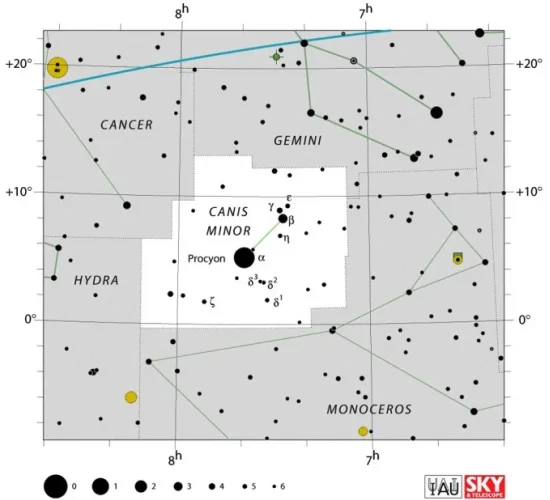
Canis Minor constellation map by IAU and Sky&Telescope magazine
Even though the Milky Way passes through it, the constellation does not have any particularly bright deep sky objects. It is best known for its brightest stars – Procyon and Gomeisa – as well as for Luyten’s Star, one of the nearest stars to Earth. Procyon is the only first-magnitude star in the constellation.
The best time of the year to observe the stars and deep sky objects in Canis Minor is during the month of March, when the constellation climbs higher above the horizon in the evening. The entire constellation is visible from locations north of the latitude 75° S.
The 10 brightest stars in Canis Minor are Procyon (Alpha CMi, mag. 0.34), Gomeisa (Beta CMi, mag. 2.84 – 2.92), Gamma Canis Minoris (mag. 4.33), HD 66141 (mag. 4.39), 6 Canis Minoris (mag. 4.55), Epsilon Canis Minoris (mag. 5.002), Zeta Canis Minoris (mag. 5.13), Eta Canis Minoris A (mag. 5.25), Delta1 Canis Minoris (mag. 5.25), and 11 Canis Minoris (mag. 5.25).
Procyon – Alpha Canis Minoris
| Spectral class | F5 IV–V + DQZ |
| Variable type | Suspected |
| U-B colour index | +0.00 |
| B-V colour index | +0.42 |
| Apparent magnitude | 0.34/10.7 |
| Absolute magnitude | 2.66/13.0 |
| Distance | 11.46 ± 0.05 light years (3.51 ± 0.02 parsecs) |
| Parallax | 284.56 ± 1.26 mas |
| Radial velocity | -4.505280 ± 0.020786 km/s |
| Proper motion | RA: -714.590 ± 2.06 mas/yr |
| Dec.: -1,036.80 ± 1.15 mas/yr | |
| Constellation | Canis Minor |
| Right ascension | 07h 39m 18.11950s |
| Declination | +05° 13′ 29.9552” |
| Designations | Procyon, Alpha Canis Minoris, α CMi, 10 Canis Minoris, HD 61421, HR 2943, GC 10277. GJ 280, SAO 115756, GCRV 5099, HIP 37279, PPM 153068, BD+05°1739, LHS 233, IRAS 07366+0520, TYC 187-2184-1 |
Procyon A
| Spectral class | F5 IV–V |
| Apparent magnitude | 0.34 |
| Absolute magnitude | 2.66 |
| Mass | 1.499 ± 0.031 M☉ |
| Luminosity | 6.93 L☉ |
| Radius | 2.048 ± 0.025 R☉ |
| Temperature | 6,530 ± 50 K |
| Metallicity | −0.05 ± 0.03 dex |
| Age | 1.87 ± 0.13 billion years |
| Rotational velocity | 3.16 ± 0.50 km/s |
| Rotation period | 23 days |
| Surface gravity | 3.96 cgs |
| Designations | Procyon A, Alpha Canis Minoris A, AG+05 1072, BD+05 1739, CCDM J07393+0514A, IDS 07341+0529 A, WDS J07393+0514A |
Procyon B
| Spectral class | DQZ |
| Apparent magnitude | 10.7 |
| Absolute magnitude | 13.0 |
| Mass | 0.602 ± 0.015 M☉ |
| Luminosity | 0.00049 L☉ |
| Radius | 0.01234 ± 0.00032 R☉ |
| Temperature | 7,740 ± 50 K |
| Age | 1.37 billion years |
| Surface gravity | 8.0 cgs |
| Designations | Procyon B, Alpha Canis Minoris B, GJ 280 B, UBV 7350, CCDM J07393+0514B, IDS 07341+0529 B, WDS J07393+0514B |